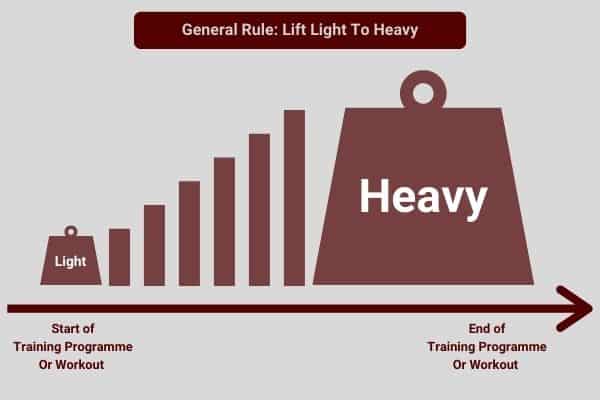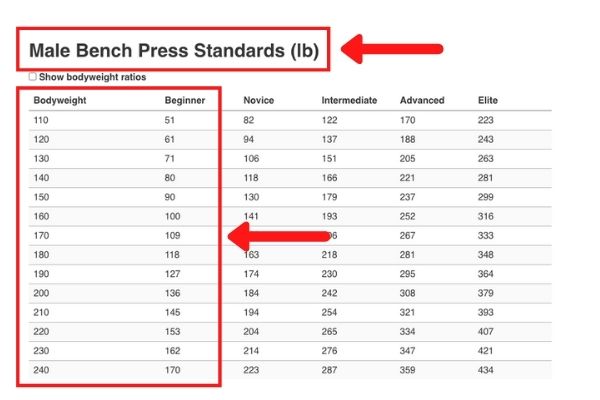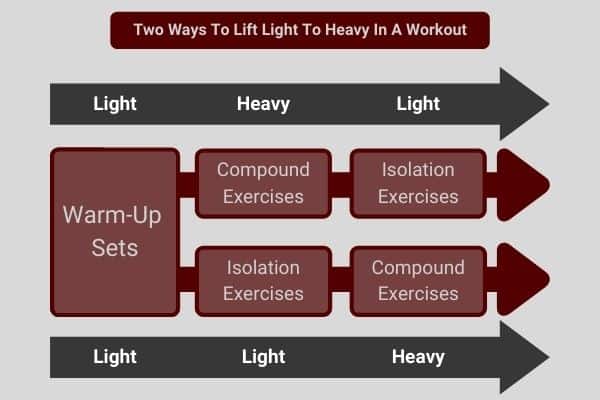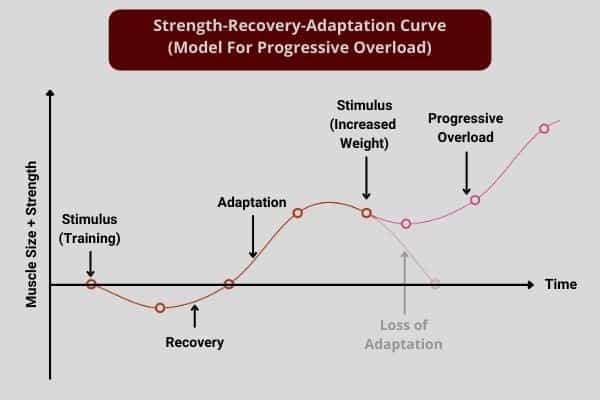You know mixed heavy and light weight training is beneficial for muscle growth. But are you puzzled by WHAT you should do first? If you are, then keep reading! Because today, I’ll be explaining whether you should lift heavy or light weights first.
Both a training program and a training session should start by lifting light weights first before progressing to heavier weights. Lifting at light loads will prepare your muscles before they undergo intense physical exertion from heavy weight lifting. This allows you to safely lift heavier weights.
I too was confused by this dilemma when I first started weight training.
That’s why today I want to share my research and personal experience (I was able to gain 40 pounds of muscle myself) into the question of training order.
Let’s jump right in!
Should You Lift Heavy Or Light Weights First?
In the context of building muscle, lifting heavy weights is recommended to promote muscle growth.
In contrast, lifting light weights is suitable for warm-ups and smaller exercises such as the bicep curl.
So should you lift heavy weights first or last?

As I previously stated, you should always lift light to heavy (as a general rule).
That being said, the question has two different meanings depending on two types of context.
The first context is within a training program.
In other words- should you begin a 12-month training program by going all out on heavy lifts? Or should you start with light weights, and then develop into heavy weights over the months?
The second context is within an individual workout.
In other words- should you start a training session by completing your heavy lifts first? Or should you begin with lighter lifts and then progress onto the heavier weights over the course of a workout?
The good news for you is that in both contexts, you should generally go from light to heavy weights.
I’ll explain why later.
Definition Of Heavy And Light Weights.
First, allow me to explain to you what I define as “heavy” and “light”.
They are, after all, very subjective phrases. A weight that is heavy for one person may be light for someone else.
So what is considered a heavy and light weight in weight lifting?
A heavy weight is one that is 60 to 100% of your maximum lifting capacity for the exercise, also known as the 1-rep max. In contrast, a light weight is one that is 0 to 60% of your maximum lifting capacity for the exercise.
Therefore, it is highly recommended to determine your 1-rep max for each exercise. And this allows you to quantitatively determine what is deemed light or heavy for your own abilities.
To estimate your 1-rep max, simply locate your exercise and details on the Strength Level database.
For a detailed explanation on this, you can check out my complete guide to different rep max’s (RM).

It will then estimate the maximum weight you can lift in one go, for a particular exercise.
From here, you can take 60-100% of your 1-rep max for a heavy weight, or 0-60% for a light weight.
This can be calculated by multiplying your 1 rep max by 0.60 to 1.00 for a heavy weight, or 0.00 to 0.60 for a light weight.
For example- if your estimated bench press 1-rep max is 51 pounds, then a heavy weight for you would be 31-51 lb, and a light weight would be 1-30 lb.
Find out how much weight to lift in my other article!
Go From Light To Heavy In A Training Programme.
As someone looking to build muscle, you will want to lift heavy weights (eventually).
That being said, as a beginner, you shouldn’t go straight into lifting the heaviest barbell at the gym! Nor should you attempt bench pressing 200 pounds just because the gym bro next to you is doing so.
That would just be a recipe for disaster.
Instead, you should start lifting lighter weights before you lift heavy weights.
By starting at a lighter weight, you can safely get accustomed to the exercises.
And once you’ve adapted to the exercise movements, and your muscles have developed a novice strength foundation, you can progress onto heavier weights.
So how much weight should you be lifting as a beginner, relative to your own bodyweight?
| Bodyweight | Bench Press | Overhead Press | Barbell Row | Squat | Deadlift |
|---|---|---|---|---|---|
| 110 lb | 41 lb | 26 lb | 36 lb | 57 lb | 74 lb |
| 120 lb | 49 lb | 30 lb | 43 lb | 67 lb | 86 lb |
| 130 lb | 57 lb | 35 lb | 42 lb | 78 lb | 98 lb |
| 140 lb | 64 lb | 40 lb | 56 lb | 88 lb | 110 lb |
| 150 lb | 72 lb | 45 lb | 62 lb | 98 lb | 122 lb |
These are relatively light weights for someone who’s been training regularly.
But from these weights, you would begin adding more weight every one to two weeks.
And this will allow you to lift heavier weights as you progress in your training program.

If you’re training with dumbbells, then a good pair of adjustable dumbbells like these Powerblock Elites will allow you to effortlessly transition from light to heavy lifting.
Go From Light To Heavy In Each Workout.
During each workout, you should also lift light weights before heavy weights.
Generally speaking, you should lift light weights to warm your muscles.
This commonly takes the form of warm-up sets before training sets.
A warm-up set involves performing the movement for a given exercise, but with light weights.
Once you’ve warmed up, you can begin your training sets.
Jay from A Workout Routine recommends the following warm-up set structure:
| Set | Weight | Reps | Rest (Seconds) |
|---|---|---|---|
| 1 | Barbell-only or light dumbbells | 10-15 | 45-60 |
| 2 | 55-60% of the weight you intend to use for training sets. | 8 | 45-60 |
| 3 | 70-75% of the weight you intend to use for training sets. | 5 | 45-60 |
| 4 | 80-85% of the weight you intend to use for training sets. | 3 | 45-60 |
| 5 | 90-95% of the weight you intend to use for training sets. | 1 | Full Rest |
This warm-up routine will ready your joints and muscles, get your blood flowing, and prepare your mind.
Once you’ve warmed up with light weights, you can then begin tackling the heavy weights, which will be your muscle-building sets.

Powerblock dumbbells are fully adjustable and each dumbbell contains light AND heavy settings, making it a great way to progress at home.
Check out my other article for tips on how to build muscle as a hardgainer!
Two Ways To Lift From Light To Heavy Weights In A Workout.
I’ve discussed why you should lift light weights in the form of warm-up sets.
But in your actual training sets, you actually have two choices:
- Lift heavy compound exercises first and lighter isolation exercises second.
- Lift lighter isolation exercises first and heavier compound exercises second.

Compound exercises (also called the “big lifts”) activate multiple muscle groups simultaneously. Examples include the 5 core lifts (bench press, overhead press, barbell row, squat, and deadlift).
They are the mass builders and you’re recommended to lift heavy on these exercises (70-80% of 1-rep max at 6-12 reps).
Isolation exercises (also called the “small lifts”), in contrast, activate single muscle groups. Examples include exercises such as the bicep curl, leg extension, lateral raise, and more.
They are used to add volume to specific muscles, and you’re recommended to lift lighter on these exercises (60 -70% of 1-rep max at 10-15 reps).
Which type of exercise you choose to do first will depend on your goal. The table below will help you decide whether you should do heavy compound lifts or lighter isolation lifts first.
You may also be interested in my other article to find out what dumbbell weights are considered to be light and heavy.
| Heavy Compound Lifts First | Lighter Isolation Lifts First |
|---|---|
| More energy for “big lifts”. | More energy for “small lifts”. |
| Increases overall mass. | Defines specific muscles |
| Develops general strength. | Develops lagging muscles. |
As you can see, whether you choose to lift heavy compound or lighter isolation first, depends on your training goal.
But regardless, you should still be lifting light-weight warm-up sets beforehand.
So technically, you should always be lifting light weights first, and then progress to heavier weights after.
Why You Should Lift Heavy Weights To Gain Lean Muscle.
So why should you lift heavy weights to build muscle?
Heavy weights are required to build muscle because they introduce mechanical tension to the muscle being trained. This stimulus causes micro-damage to your muscle fibers, and the subsequent repair process causes muscle fibers to be recruited at a greater volume and number than before.
As I mentioned previously, the best way to lift heavy weights is to first start with light weights and progressively increase the weight over time.
This process is called progressive overload, and it is essential to gain muscle.
To understand why progressive overload is important, take a look at the stimulus-recover-adaptation model below.

As you can see- it’s important to introduce progressively more demanding stimuli for your muscles to grow.
Without progressive overload, your muscle gains would plateau very quickly.
And that’s no good if you want to gain a significant amount of muscle!
If you’re interested, you may also be interested in my other article to learn how progressive overload works with dumbbells.
Do Bodybuilders Lift Heavy Or Light Weights First?
Now let’s take a look at how the elite build muscle- the bodybuilders.
And what better example to use than the legend, that’s Arnold Schwarzenegger?
Here are Arnie’s views on whether to lift heavy or light weights first.
In agreement with this post, Arnie advocates light warm-up sets before jumping into your heavy compound lifts.
However, he also backs what he calls the “Shocking Principle“.
To put it simply, you should always find ways to introduce a new stimulus to your muscles. And this forces them to keep adapting, to keep growing.
Therefore, by all means, focus on lifting heavy compound weights before light isolation weights.
But every once in a while, it could be also beneficial to lift light isolation weights first. This will “shock” your body to grow.
If you’re interested, you can go to my other article for a home dumbbell bodybuilding workout!
Conclusion
There we have it.
Today, I’ve explained whether you should lift heavy or light weights first.
Generally speaking, you should always lift light before progressing to heavy weights in a training program.
Additionally, you should also lift light weights (in the form of warm-up sets), before lifting heavy weights in a workout.
After your warm-up sets, it can be beneficial to do either heavy compound lifts first or light isolation lifts first. It really depends on your goal. And it’s often best to keep things varied on a regular basis.
Do YOU prefer to lift heavy weights or light weights first?
Let me know in the comments!
Alternatively, download the FREE Kalibre Muscle Blueprint to find out EXACTLY how I transformed my skinny body as a hardgainer!
Thanks for reading guys!
Peace Out,
Kal
(Biochemistry BSc, Biomedical Sciences MSc, Ex-Skinny Guy)


